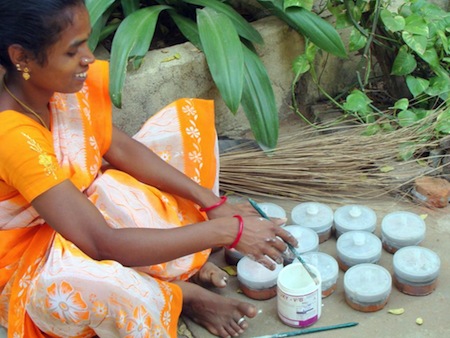The Science of Dirt (Part 2): High hopes for the scalability of $12 water micro-filters made of natural elements
Editor’s note: This is the second of a two-part Q&A blog with Chandrasekaran Jayaraman (Chandra), a serial social entrepreneur based in Chennai, India, who’s currently building and selling affordable, electricity-free, maintenance-free water filters made out of clay, sand and sawdust in India. Chandra has a bachelor’s degree in chemistry and a postgraduate degree in plastics and has 25 years of industrial experience.
In Part 1 published yesterday, Chandra described how he was helping restore dilapidated temples in buildings all over India when he saw firsthand that most villages don’t have good drinking water or toilets, and most villagers don’t understand the implications of untreated water and open defecation. So he set to work refining the government’s patented technology to make water micro-filters using clay, eventually founding his own company, Watsan Envirotech. The filters can be made indoors, year-round, using a gasifier fueled by sawdust waste in a process that he says emits no carbon.
Below, Chadra describes more about his production system and the scalability of his business.
Kyle Poplin: Describe some the advantages and disadvantages of your production system.
Chandra: The advantages are many:
• These candles work on a microfiltration method, holding back the pathogens and iron particles which contaminate water, and allow only clean water to percolate.
• Wastage of water is nil.
• This process does not need electricity, unlike the reverse osmosis plants.
• This process retains good salts which are essential for our body to build immunity against diseases and also strengthen our bones, whereas reverse osmosis removes the good salts.
• The candles can be made smaller or bigger, depending on the need and consumption of the end users.
• Replacement costs are negligible, unlike reverse osmosis, as the clay candle filters need only to be washed well to remove the sludge formed on the top layer, enabling them to filter repeatedly as long as one can use them.
Watsan now has a 15-liter standalone model, 2,500-liter tanks for schools and public entities, and we are soon coming out with a coconut-shaped 300-liter model which is aesthetically more appealing.
(Part of the proces of making clay filters, left.)
K.P.: How much do you charge customers for these filters? Do you find that people at the base of the pyramid can afford them? How many have you sold and how many do you believe you can sell?
Chandra: The standalone 15-liter filters, which replace the bubble-top cans in houses, cost roughly U.S. $12, the 2,500-liter tanks cost around $800 and the coconut-shaped filter is yet to be launched. We have sold to almost to 40,000 households, and a few schools and colleges as well, from Assam to Kanyakumari, covering the length and breadth of India.
Significantly, we covered on a trial basis the iron-infested northeast states and a few districts in my own state, Tamilnadu, and since the results were superior to any high-end technology, we decided to scale up straight away with 1,000 times larger capacity automation.
K.P.: Is this a sustainable business?
Chandra: Look at these figures, then you tell me if water filtration is a sustainable business: the compound annual growth rate of the water purifier industry in India is about 25 percent; potential business is $70 billion by 2015, up from the current level of $32 billion; sales of water purifiers in India should exceed 15 million units by 2015, up from the current level of 780,000 units; and global growth in the water purifier industry is estimated at 8 percent. This growth is driven by the extreme shortage of drinking water, the dwindling water table, rising sales of low-cost variants and the huge demand-supply gap of clean water.
K.P.: Do you hope to expand to other countries besides India? If so, what criteria will you use to make that decision?
Chandra: Yes, of course! A criterion is the seller must be passionate about providing clean water to the needy. He can start small or big, but he should start giving.
We have studied water contamination in many Southeast Asian countries as well as in African countries, and that bodes well for selling this product elsewhere, anywhere. We have enough data to substantiate our hope for exports from India in the near future.
K.P.: What advice would you give other entrepreneurs trying to do business at the base of the pyramid?
Chandra:
• First, look carefully at the pain point you are addressing.
• Ascertain the geographical spread you’re catering to.
• See if your product is cost effective and affordable to the poorest of the poor.
• Make a pilot or prototypes without burning much of your cash or, of course, your dad’s!
• If the product is good, consult experts on the pros and cons of manufacturing, and then try pilot lots.
• If the pilot produces consistent results, go for the big bang! Money and orders will follow.
Kyle Poplin is the editor of NextBillion Health Care.
- Categories
- Agriculture, Health Care
- Tags
- manufacturing, product design, scale

